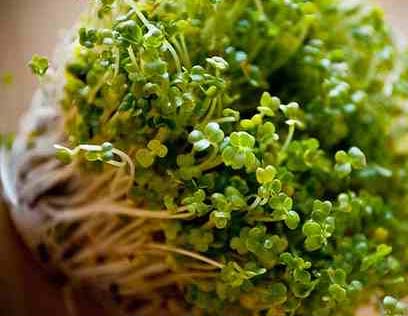 The seedlings are different from the sprouts, that they represent the next stage of plant development; the seedling is already a young independent plant.
The seedlings are different from the sprouts, that they represent the next stage of plant development; the seedling is already a young independent plant.
Wheat seeds are most suitable for growing seedlings, buckwheat and sunflower. Additionally, except jars, soil and plastic trays or large pot holders approx. 2—3 cm.
Here is a brief instruction:
1. Soak the seeds for approx. 10 hours.
2. Pour out the water. The seeds germinate for approx. 2 days without rinsing. (You can rinse the sunflower seeds and buckwheat if necessary, especially on dry days).
3. Pour soil on the tray and smooth the surface. The thickness of the soil layer should be approx. 2 cm.
4. Water the soil, until it is well moist.
5. Sprinkle the seeds thinly over the surface of the soil, a dense layer.
6. Cover with the second tray (upside down) or paper or other opaque material. Keep warm 3 days.
7. After removing the top tray (covers) and discovering the seedlings, water them thoroughly and expose them to the sun. Water every day.
8. About 7-8 days after the start of cultivation, the "harvest" can be carried out, cutting the seedlings with a sharp knife close to the roots.
Sunflower seedlings and buckwheat can be added to sandwiches, soups, salads. Wheat seedlings are too hard for direct consumption, however, they are great for juice.
We obtain the juice using a juice machine. In the past, such machines were available in Poland and were used to obtain tomato juice. If we don't have a juicer, we can (Chew a few blades of wheat several times a day (much healthier than chewing gum!) or grind the seedlings in a meat grinder, and squeeze the juice through gauze.
Wheat seed juice has a very intense cleansing effect, Nutritional and curative, for example, heals ulcers (it can be used both internally and externally), anemia, inhibits the growth of tumors by cleansing and renewing the blood.
Wheat seed juice owes its properties to chlorophyll and the richness of minerals and vitamins. We start drinking this juice regularly with small amounts (ok. 1 teaspoons), and we end with approx. 100 ml (it can be mixed with other juices, for example from carrots). It is also good to take breaks from time to time when using the juice regularly; 2, 3 days a week or one week a month. Due to the cleansing effect of wheat seedling juice, it is better not to start this treatment during pregnancy or lactation. Also remember, that this juice cannot be stored, it is only suitable for direct consumption.
